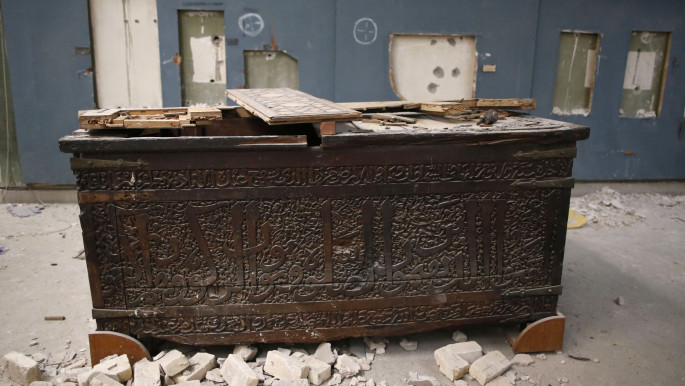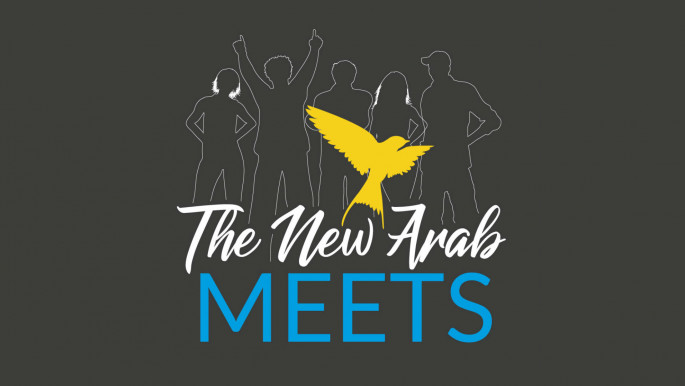Mending scars through heritage: Geologist who fought IS helps save Mosul's antiquities
The destruction IS left behind, as well as the atrocities it committed in its three year rule, spared no one, not even its ancient lamassu stone statues, dating from about 100 BC. to 100 AD.
Faisal Jeber, a trained geologist, witnessed all of it.
From the first days when IS took over to later, to when he joined the 11th regiment Mosul's Gallants Force (MGF) a local mobilisation force with 144 volunteers trained by the US to fight IS, until Mosul, and its surrounding territories, were liberated.
Yet his most difficult task, to protect and salvage the city's archaeological heritage, had only just begun. Caught between political cross-fire with Baghdad and the dire emergencies of Mosul's traumatised civilians, little has been done to date to look after and rebuild the museum and other heritage sites left in rubble.
According to the United Nations [UN] more than half of the old city has been destroyed.
Jeber is determined that heritage recovery is an essential aspect of the reconstruction process: bringing an element of unity and common heritage to a city ravaged by war and haunted by its memories.
The American Schools of Oriental Research (ASOR), which tracks heritage destruction, attributes the damage of 15 religious sites in Mosul to IS. It also mentions however, that the American-led coalition damaged 47 sites to recapture the city, of which 38 were largely destroyed, as noted by The Economist.
The New Arab speaks to Faisal Jeber about the current state of the museum in Mosul, what he saw when it was first liberated and the work of his NGO, the Gilgamesh Centre for Antiquities and Heritage Protection:
What did you see when you first entered the Mosul museum?
"I could not hold my tears when I entered the museum, it was dark, rubble everywhere, and the smell of smoke pervaded the rooms. There were no booby traps inside but there was still fighting ongoing outside."
Faisal recalls vividly when in 2011 he visited the museum for the first time during a private visit. The building was divided in two stories with pre-historic and Assyrian art and the Islamic gallery.
 |
|
| Iraqi forces inspect the damage inside the destroyed museum of Mosul on April 2, 2017 [Getty] |
"As a leader of MGF I was able to gain access to archaeological and heritage sites during the liberation or shortly after when they were most vulnerable to looting and in need for first aid. When we accessed the museum after the conflict, some statues had been moved, others could not be located at all, leaving many questions unanswered till now.
"At another site in Nimrod, when it was liberated on November 1, the antiquities had been left by IS without a roof, and the material they are made of was at high risk of irreparable damage. Together with the 11th regiment they ensured the antiquities were immediately shielded from the rain, rescuing them.
"But what is even more disconcerting is that it is impossible to trace the exact damage and loss under IS rule because no inventory of the Mosul museum updating and listing the artefacts after 2003 exists, as confirmed by the museum's director during a live TV show. In short: we don't know what was underground in the museum before IS took over."
 |
What is even more disconcerting is that it is impossible to trace the exact damage and loss under IS rule because no inventory of the Mosul museum updating and listing the artefacts after 2003 exists |  |
What is the status of lost heritage smuggled and sold by IS?
"The estimated loss of antiquities in monetary terms has been assessed at $4 billion, with the biggest markets for the goods in the Gulf and a smaller one via Turkey to Europe and North America.
"A container marked as carrying 'construction tiles' was recently seized in the UAE. It contained 4,500 pieces of different artefacts, roughly 3,500 came from Iraq. Despite the implementation of a very strict law in Iraq which sentences antiquity-smugglers to 20 years in jail, part of the reason for the volume of the smuggling of stolen artefacts via Kuwait to other Gulf countries, is due to their failure to adhere to UN regulations for the protection of antiquities, hence indirectly facilitating the illegal trade in these countries."
 |
The estimated loss of antiquities in monetary terms has been assessed at $4 billion, with the biggest markets for the goods in the Gulf |  |
How did you transition from fighting IS on the battlefield to defending Mosul's heritage?
"I founded the Gilgamesh Centre for Antiquities and Heritage Protection in 2015 when IS began to destroy Mosul's history and art.
"Although I was living abroad in 2014, I was in Mosul visiting my family when IS took over in June. I remember those first days, we had no idea what was coming, or at least not to which extent. I took my car and drove downtown, the streets were almost empty, with only a few cars on the roads. Some days later my family and I decided to leave.
"I would return in 2016 as a soldier fighting IS as part of the 11th regiment. Our task was to stabilise areas that had already been recaptured where sleeper cells were still active.
"When the city was liberated the museum was placed under the protection of the federal police but little to nothing was being done to recover or protect the precious artefacts it contained. A new era of lawlessness and smuggling had begun with IS. Through the work of the centre we discovered new tunnels.
In the Nineveh plains, 17 lamassu statues had vanished. We entered the Nabi Younis tunnel in East Mosul first on April 2, 2018 which led us to the discovery of two of the missing lamassu statues. The Gilgamesh Centre was working from day one in October 2017 to create an initial assessment of the damage suffered.
"A recent example of the 'first aid' carried out by the centre is in the town of Alqoush, at the prophet Nahum shrine. In some cases, when we first visited the Al Nouri mosque, there were still mortars being fired. We recently ran a seminar on the importance of digitalising and preserving manuscripts to counter in the future an inadequate knowledge and listing of artefacts."
 |
|
| A damaged artefact stands inside the destroyed museum of Mosul [Getty] |
What struck you most of those first days after IS takeover of the city?
"I drove to Mosul University and in my mind ran scenes from April 2003, when Saddam Hussein was overthrown following the US armed intervention in Iraq. So I was expecting to see looting and destruction, as had been the case in 2003.
"When I reached the main gate there two veiled men were standing in front of the gate with AK47s, preventing anyone from entering it. Downtown by the government compound and Mosul Museum (the second largest museum in Iraq) there was no one, I saw only four corpses crucified at the fence of the Iraqi central bank branch.
"I was arrested and tortured by IS on the second day while I was taking pictures and interviewing IS members when they realised my watch, a Garmin Forerunner 910XT, had a GPS service. After three days they released me and I escaped with my family to Baghdad. I found out immediately, during that first week what IS intentions were for our heritage sites: they were going to destroy them. That is when I decided to launch the initiative, persuading a group of friends to establish Gilgamesh Centre for Antiquities and Heritage Protection. We held seminars, press conferences and published an initial report titled Heritage Massacre, published as an official report at the ministry of culture website.
What is the biggest obstacle at present to save and protect the city's art and history?
"There are several aspects that delay and complicate efficient intervention on the ground. Firstly, there is a lack of coordination with the central government in Baghdad, which in my opinion reflects the lack of interest. A lot more needs to be done by the central government.
"Through heritage we can mend scars tied to the lack of national identity and this in turn will help in offsetting tendencies for radicalisation.
"It is very hard to expect homeless civilians, with no shelter, traumatised by war to think of preserving heritage as their priority. In Nimrud city for example we were running everywhere like headless chickens to get somebody to guard it as locals started looting 3,000-year-old bricks to repair their houses. Local police force was involved in the fighting, other troops had their own priorities."
 |
It is very hard to expect homeless civilians, with no shelter, traumatised by war to think of preserving heritage as their priority |  |
Can anything 'positive' be learned for Mosul heritage from this tremendously harsh period for its population and sites?
"Yes, I believe so. If we examine the 'Repentance Hill' (Taouba) we see that it has four layers: Esarhaddon palace, from 612 BC Zartosht temple, from 336 BC a Christian monastery until 550 AD the Islamic Nabi Yunus Mosque, since 900 AD.
"IS militants seized control of the mosque and closed its doors, preventing worshipers from entering it to pray. On July 24, 2014, the building was blown up by them claiming that the mosque had become a place for apostasy, not prayer. However, there were also other three reasons to demolish the mosque: to look for (and loot) antiquities in Esarhaddon palace under the mosque's foundations. According to my initial damage assessment of the mosque foundations, and the tunnels network under it (around 900 metres long), it's impossible to rebuild it as it was before, as the whole mosque is prone to collapse due to intense digging under it.
"To rebuild it, the entire compound should be removed with its multi-layered foundations. Amid so much destruction this will allow however to excavate all four layers of civilisations and place the Esarhaddon palace, Zartosht temple, Jonah's monastery, and the Nabi Yunus mosque next to each other on top of this Ziggurat to be an icon for peaceful co-existence, hopefully as a beacon to restore a national identity to Iraq which has been suffered many blows since 2003."
 |
|



